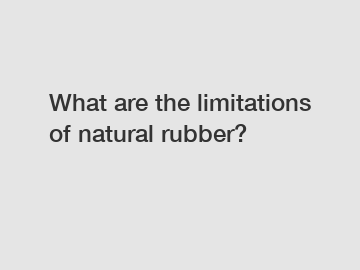What are the limitations of natural rubber?
What are the limitations of natural rubber?
Natural rubber is a widely used material in various industries, from automotive to manufacturing, due to its excellent properties. It is known for its elasticity, tensile strength, and resistance to wear and tear. However, like any material, natural rubber also has its limitations. In this article, we will explore and discuss the constraints of natural rubber, providing a comprehensive understanding of its drawbacks.
1. Sensitivity to temperature:

One of the significant limitations of natural rubber is its sensitivity to temperature changes. Extreme heat can cause rubber to become soft, lose its strength, and even melt. On the other hand, extreme cold can make it brittle, affecting its elasticity. This temperature sensitivity restricts its applications in environments with harsh weather conditions.
2. Poor resistance to chemicals:
While natural rubber has good mechanical properties, it exhibits poor resistance to a wide range of chemicals. This characteristic limits its use in industries that involve exposure to oils, solvents, and other harsh chemicals. When exposed to these substances, natural rubber can deteriorate, leading to degradation, swelling, or even dissolution.
3. Susceptibility to UV radiation:
Another limitation of natural rubber is its vulnerability to ultraviolet (UV) radiation. When exposed to sunlight over extended periods, rubber products can experience degradation, resulting in cracking, discoloration, and loss of mechanical properties. Consequently, natural rubber is typically not recommended for applications that involve outdoor exposure.
4. Low heat resistance:
In applications where temperature resistance is crucial, natural rubber falls short due to its low heat resistance. If exposed to high temperatures for a prolonged period, rubber can deform, melt, or lose its structural integrity. This makes it inappropriate in industries such as aviation and electronics, where materials must withstand extreme heat conditions.
Despite these limitations, it is important to acknowledge that natural rubber has numerous advantages as well. It remains an essential material in many applications where its limitations can be addressed through various methods, such as formulation and processing techniques. Additionally, alternative synthetic rubber materials have been developed to overcome some of the constraints mentioned above.
To mitigate the limitations of natural rubber, scientists and engineers have developed techniques such as vulcanization, which involves adding additives like sulfur to improve its resistance to temperature, chemicals, and UV radiation. Vulcanization also enhances the mechanical properties of rubber, making it more durable and suited for a broader range of applications.
Advancements in polymer science have led to the development of synthetic rubbers, such as neoprene and silicone, which possess enhanced resistance to heat, chemicals, and UV radiation. These synthetic rubber materials have found their way into industries where natural rubber falls short. However, it is worth noting that these synthetic options often come at a higher cost.
In conclusion, while natural rubber offers excellent properties such as elasticity and tensile strength, it does possess some limitations. Sensitivity to temperature, poor resistance to chemicals, vulnerability to UV radiation, and low heat resistance are among the drawbacks associated with natural rubber. However, through the use of additives, various processing techniques, and the development of synthetic rubber materials, many of these limitations can be mitigated. As technology advances, it is likely that the limitations of natural rubber will continue to be addressed, allowing for its continued use in a wide range of applications.
For more Low Price Diamond Hammer Top Cow Rubber Mat, High Abrasion Resistance Nr Rubber Sheet, Hammer Top Cow Rubber Mat China Supplyinformation, please contact us. We will provide professional answers.

Comments
0